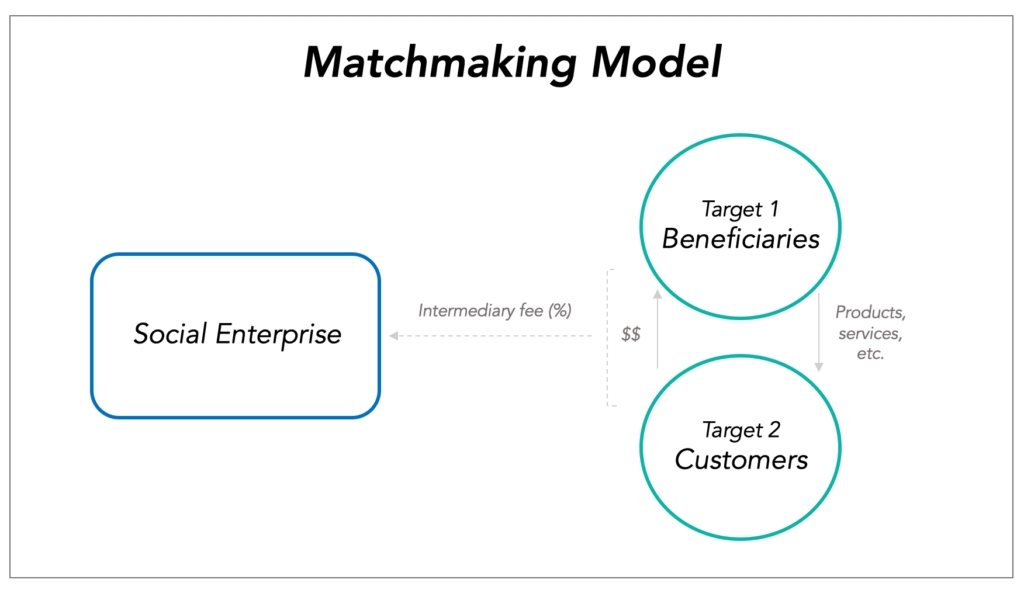
Matchmaking model for social enterprises
Definition and real-life case studies
The rise of online platforms such as AirBnB and Uber turned the spotlights on new ways of doing business. In previous articles, we already discussed the difference between product model and solution model, as well as key aspects of multisided business models. Finally, it’s time to get more familiar with another business model: the matchmaking model!
In this post, we discuss what this model looks like and how social enterprises can leverage it to create positive social change.
Matchmaking model briefly explained
In a matchmaking model, the firm brings together two complementary groups: customers and sellers. By doing so, the company provides a transactional value, as it facilitates the exchange between demand and supply. As a rule of thumb, firms following this framework have to create a marketplace to make the exchange actually happen. It can be either physical or digital, doesn’t really matter. Also, to remain financially viable, they usually charge brokerage fees for each transaction or charge one of the sides for the privilege of using the marketplace.
Now, matchmaking models can slightly differ when applied in the social sector. For ease of understanding, we identified two main sub-categories falling into this cluster.





On one hand you have the “market intermediary model“. Here, the enterprise physically connects beneficiaries with markets interested in their products/services, acting either as an intermediary or as a re-seller. On the other hand, you have the “platform as intermediary model“, with online platforms linking two complementary segments. Typical examples of this sort are fundraisers/donors, buyers/sellers, and so forth.
The key point to keep in mind for both variants is that beneficiaries, without a social firm acting as an intermediary, wouldn’t be able to get access to the market.
Matchmaking model in practice: few examples
Airbnb, Uber, Expedia are just few examples of successful for-profit companies using matchmaking models. Yet, we can find some in the social sector too.





Just consider StartSomeGood, for instance. This Australian company launched in 2011 the first crowdfunding platform to get social innovations funded. By using a “platform as an intermediary model“, StartSomeGood successfully facilitates exchanges between social entrepreneurs and donors/funders, charging a commission only (if and) when the funding goal has been reached.
Another great example is Fairtrade International. Its core mission is to ensure decent working conditions and fairer incomes for farmers and workers in developing countries. Thanks to its national/local organizations, Fairtrade International markets and promotes products with a “FAIRTRADE mark” in different consumer countries. Again, the company acts as an intermediary, following a “market intermediary model“.
These are just couple cases, but (luckily enough) the list goes on and on..!
Things to keep in mind
Matchmaking businesses bring together buyers and sellers, most of the times without even owning what is actually bought and sold. Because of that, matchmaking models typically allow leaner structures and lower costs of inventory or assets, especially for those firms that choose to run online/digital marketplaces (just like StartSomeGood does). As a consequence, firms using matchmaking models are often able to scale up more quickly and easily than others.
But there is another side of the coin too. Since margins are usually small, viability strongly relies on volumes. Also, it’s important to remember that matchmaking is only possible when there is a real value exchanged between the two parts. In fact, what if customers start seeing the products/services sold in a specific marketplace as useless? They would stop buying them, the social enterprise wouldn’t receive any brokerage fee, and the whole system would soon fall apart. This is why it’s critical to build the matchmaking activities around solid, durable value exchanges.





Conclusion
Only in recent times, running a marketplace and making a business out of it has become widespread. This is how “matchmaking business models” became mainstream, both in for-profit and non-profit sectors.
As we discussed, social enterprises adopting a matchmaking model help beneficiaries get access to a market for their products/services. At the same time, such firms reduce the search effort for customers, typically asking for brokerage fees in return.
Finally, matchmaking models come with several risks, but also with tremendous chances for scalability and growth. So, what about your business idea? Have you identified two groups of people (or companies) with fragmented, complementary needs that need to be matched? Can you act as an intermediary, making sure that one side won’t outgrow the other once conveyed in a specific marketplace? If so, then a matchmaking model might be the best choice for your project!
Did you like this article?
If so, then don’t forget to check out for more at Social Business Design.